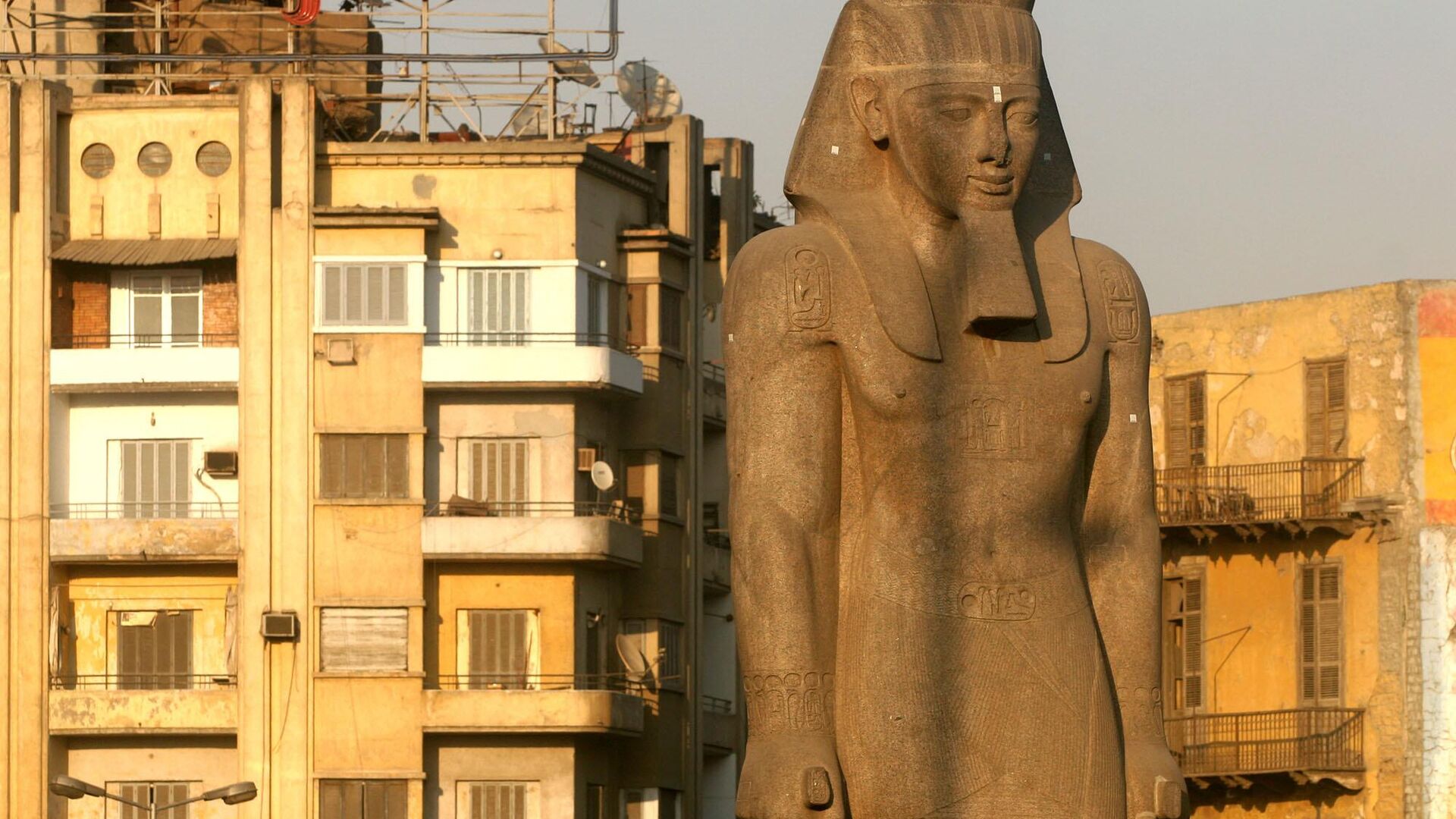https://sputnikglobe.com/20221225/researchers-recreate-two-facial-depictions-of-egyptian-pharaoh-ramses-ii-using-ct-scan-technology-1105780761.html
Researchers Recreate Two Facial Depictions of Egyptian Pharaoh Ramses II Using CT Scan Technology
Researchers Recreate Two Facial Depictions of Egyptian Pharaoh Ramses II Using CT Scan Technology
Sputnik International
Pharaoh Ramses II belongs to the nineteenth dynasty in Ancient Egypt, where his rule extended between 1279 and 1212 BC. Nicknamed by his successors and... 25.12.2022, Sputnik International
2022-12-25T10:40+0000
2022-12-25T10:40+0000
2023-04-21T10:43+0000
africa
egypt
pharaoh
ramses the great
science & tech
https://cdn1.img.sputnikglobe.com/img/07e6/0c/19/1105780596_0:0:2000:1125_1920x0_80_0_0_f6862017525df5c18ab6738c851df8dd.jpg
Scientists were able to re-design the “handsome face” of the most famous pharaoh in Ancient Egypt, King Ramses II, by using a 3D model of his skull, in order to reconstruct his features scientifically.A team of researchers from Cairo University in Egypt and the Face Lab at Liverpool John Moores University (LJMU) in England have collaborated to reconstruct the facial features of Ramses II at the time of his death, at the age of 90, and at the younger age of 45, using a “digitally unwrapped” scan of his mummy displayed at the National Museum of Egyptian Civilization in Cairo, Egypt.The two detailed images were created by means of computerized tomography (CT) scan technology, which is proved to allow accurate facial reconstruction, along with analysis software to parse out details in accordance with typical Egyptian measurements of facial muscle layers, explained Dr. Sahar Saleem, a professor of radiology at Cairo University and co-leader of the project.The scholar argued that average measurements of facial muscle layers differ from one population or ethnicity to another in various parts of the face, including “including the slant of the forehead, and the nasal, malar, and labial regions.”“The most scientific approach is to use measurements from a population that is as close as possible to your subject — which is what we did,” said Saleem, who managed to CT scan more than 40 royal mummies, including Egyptian ruler Tutankhamun (c. 1341-1323 BC) whose face was re-generated earlier this month. “The visualization of fine facial features such as ear piercings and hairstyle was also made possible by modern image reconstruction software.”Co-leader of the project and director of the Face Lab at LJMU, professor Caroline Wilkinson, along with the joint team of scientists, spent three months generating the Egyptian ruler’s face 3,300 years after his death.The researchers first reconstructed the face of Ramses II at the age of 90 when he died. Then they reverse the aging process, turning back the clock, to reveal his face at the peak of his power at the age of 45.
https://sputnikglobe.com/20221126/gilt-laced-chat-with-the-gods-mummies-with-golden-tongues-dug-up-in-egypt-1104728537.html
africa
egypt
Sputnik International
feedback@sputniknews.com
+74956456601
MIA „Rosiya Segodnya“
2022
Muhammad Nooh Osman
https://cdn1.img.sputnikglobe.com/img/07e4/08/0e/1080170965_2:0:2050:2048_100x100_80_0_0_1de8233c87df0979e7e74f61b6ffacad.jpg
Muhammad Nooh Osman
https://cdn1.img.sputnikglobe.com/img/07e4/08/0e/1080170965_2:0:2050:2048_100x100_80_0_0_1de8233c87df0979e7e74f61b6ffacad.jpg
News
en_EN
Sputnik International
feedback@sputniknews.com
+74956456601
MIA „Rosiya Segodnya“
Sputnik International
feedback@sputniknews.com
+74956456601
MIA „Rosiya Segodnya“
Muhammad Nooh Osman
https://cdn1.img.sputnikglobe.com/img/07e4/08/0e/1080170965_2:0:2050:2048_100x100_80_0_0_1de8233c87df0979e7e74f61b6ffacad.jpg
egypt, pharaoh, ramses the great, science & tech
egypt, pharaoh, ramses the great, science & tech
Researchers Recreate Two Facial Depictions of Egyptian Pharaoh Ramses II Using CT Scan Technology
10:40 GMT 25.12.2022 (Updated: 10:43 GMT 21.04.2023) Muhammad Nooh Osman
Writer/Editor
Pharaoh Ramses II belongs to the nineteenth dynasty in Ancient Egypt, where his rule extended between 1279 and 1212 BC. Nicknamed by his successors and subsequent rulers as the great-grandfather, Ramses II is considered the most famous and most powerful pharaoh throughout the Egyptian Empire.
Scientists were able to re-design the “handsome face” of the most famous pharaoh in Ancient Egypt, King Ramses II, by using a 3D model of his skull, in order to reconstruct his features scientifically.
A team of researchers from Cairo University in Egypt and the Face Lab at Liverpool John Moores University (LJMU) in England have collaborated to reconstruct the facial features of Ramses II at the time of his death, at the age of 90, and at the younger age of 45, using a “digitally unwrapped” scan of his mummy displayed at the National Museum of Egyptian Civilization in Cairo, Egypt.

26 November 2022, 13:04 GMT
The two detailed images were created by means of computerized tomography (CT) scan technology, which is proved to allow accurate facial reconstruction, along with analysis software to parse out details in accordance with typical Egyptian measurements of facial muscle layers, explained Dr. Sahar Saleem, a professor of radiology at Cairo University and co-leader of the project.
“I find the reconstructed face is a very handsome Egyptian person with facial features characteristic of Ramses II — the pronounced nose, and strong jaw,” Saleem said in a statement. “The software identifies the properties of the various layers of materials on the mummy’s face, such as overlying linen bandages, and allows for the digital unwrapping of the pharaohs.”
The scholar argued that average measurements of facial muscle layers differ from one population or ethnicity to another in various parts of the face, including “including the slant of the forehead, and the nasal, malar, and labial regions.”
“The most scientific approach is to use measurements from a population that is as close as possible to your subject — which is what we did,” said Saleem, who managed to CT scan more than 40 royal mummies, including Egyptian ruler Tutankhamun (c. 1341-1323 BC) whose face was re-generated earlier this month. “The visualization of fine facial features such as ear piercings and hairstyle was also made possible by modern image reconstruction software.”
Co-leader of the project and director of the Face Lab at LJMU, professor Caroline Wilkinson, along with the joint team of scientists, spent three months generating the Egyptian ruler’s face 3,300 years after his death.
“When we look at a skull for the first time, we are initially looking for the most visible characteristic details. For example, on Ramses II, there is a very wide nasal bone. It is, between the eyes, very high and very pronounced,” said Wilkinson. “The stronger a muscle is where it is anchored, the more its attachments will leave visible marks on the surface of the skull.”
The researchers first reconstructed the face of Ramses II at the age of 90 when he died. Then they reverse the aging process, turning back the clock, to reveal his face at the peak of his power at the age of 45.






